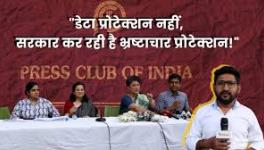Reforming the Regulator: Parliamentary Committee Report on Medical Council of India

Image Courtesy: en.wikipedia.org
The World Health Organisation (WHO) identifies India as one of the 57 countries with a critically low level of human resources available for healthcare. This would not come as a surprise given the evidence in the country of widespread shortages of skilled health workers of all kind including doctors, nurses and other health workers – in most parts of the country. The shortage of health workers and the attendant poor quality of skills in a large proportion of them is one of the biggest obstacles to the availability of quality healthcare services in India.
The recently released 92nd Report of the Parliamentary Standing Committee on Health and Family Welfare focuses on the widespread malaise that afflicts the Medical Council of India (MCI) – the apex body that is tasked with regulation and monitoring of medical education and practice in India. The report indicts the MCI for an array of malpractices, both of commission and omission. While almost all of what the report contains has been available in public domain for long, the Parliamentary Committee report is nevertheless an important document as it also lays out a plan for complete restructuring of the MCI.
The MCI has been in the news over the past few years for all the wrong reasons. Particularly scandalous was the persistence with Dr.Ketan Desai as the President of MCI even after he faced several criminal charges, including one of receiving a substantial bribe in exchange for a favorable inspection report to a private medical college. The CBI is bekieved to have recovered 1.5 kg of gold and 80 kg of silver from Desai's premises and gold worth ₨ 35 lakhs were recovered from Desai's bank lockers in Ahmedabad. The public uproar that ensued finally forced the government to supersede the MCI and replace it with an ad hoc nominated structure in 2010. However, when the MCI was again duly constituted the same Kean Desai got himself nominated to the council from Gujarat!
Capture of MCI by a lobby of private doctors
The MCI is a classic example of the principle of ‘regulatory capture’ i.e. a situation where those who are sought to be regulated, end up by capturing the regulatory mechanisms and mould them to suit their narrow interests. Since its inception the MCI has been composed entirely (except for a few ex-officio appointments) of a privileged section of the medical profession. Most MCI members are elected by different constituencies of doctors, and have over time, come to be dominated by a select (and often corrupt) clique of private medical practitioners. The Committee report candidly points to this and remarks that: “…the MCI, as presently elected, neither represents professional excellence nor its ethos. The current composition of the Council reflects that more than half of the members are either from corporate hospitals or in private practice. The Committee is surprised to note that even doctors nominated under Sections 3(1) (a) and 3(1) (e) to represent the State Governments and the Central Government have been nominated from corporate private hospitals”. Clearly powerful lobbies have successfully co-opted state and central governments to play along with their nefarious objectives.
The Committee report further notes that the MCI is dominated by specialists in the disciplines of surgery and medicine and this impacts on decisions regarding licenses to run specific post graduate and super-specialty courses in different medical colleges. The report says: “setting up of the standards and evaluation of these standards by the same professionals, may result in a conflict of professional interests”.
The Committee also correctly points out that the MCI functions like a closed club of medical practitioners form certain disciplines and goes on to say that “non-inclusion of public health experts, social scientists and health economists, etc in the MCI is one of the important reasons for the inability of the MCI to address some of the problem areas like UG curricula being not suitable for requirements of practice in rural and resource poor settings; disconnect between health system and medical education system; complete lack of training in ethical practice; and clustering of medical colleges in certain states and in metro/mega cities, etc.”
MCI has failed to nurture and expand medical education
The MCI has multiple functions, including the accreditation of medical colleges, the maintenance of standards in accredited colleges and the expansion of medical education across the country, the conduct of examinations at the undergraduate and post graduate levels, the maintenance of a register of medical graduates and the oversight of ethical conduct of medical practitioners. The report extensively documents how the MCI has failed to discharge its duties in each of these areas, often for motivated reasons.
The report describes the dire situation that exists in India as regards availability of trained doctors. Currently six states with 31% of India’s population account for 58% of the MBBS seats, while eight states which comprise 46% of India’s population have 21% of the MBBS seats. Consequently states of North, North-East and Central India have a severe shortage of doctors because of paucity of medical colleges. Further, around 70% of medical professionals work in the private health sector and around 70% of these are concentrated in urban well-to-do areas.
The doctor-population ratio in India stands at 1:1674 against the WHO norm of 1:1000. Consequently a bulk of poor patients depend on unqualified practitioners – the report quotes a study which finds that in rural Madhya Pradesh only 11% of the sampled health-care providers had a medical degree, and only 53% of providers had completed high school . The situation is particularly bad in public services, which report a shortfall of 83.4% of surgeons, 76.3% of obstetricians & gynecologists, 83.0% of physicians and 82.1% of pediatricians. Further, 700 million people have no access to specialist care and 80% of specialists are working in urban areas.
Private medical colleges fuel corruption in MCI
A key reason for the utter lack of a planned approach to human resource development and deployment in healthcare is the corrupt manner in which the MCI has functioned while carrying out its tasks of accreditation of medical colleges and the maintenance of standards of care. Currently, there are 412 medical colleges of which 53% (217) are from private sector and 47% (195) from Government. The Committee’s report, however, fails to draw the correct conclusions, after having noted trend of increasing privatization of medical education. The rapid expansion of private medical colleges has been fuelled in the post-economic liberation phase, since the early nineties, coinciding with the drying up of public funding for setting up of medical colleges. The Committee’s report does however point to the lack of seriousness in pledging public funds for medical education. The report states that: “the Ministry had put in place a Centrally Sponsored Scheme wherein 58 medical colleges would be set up during the 12th plan period which will lead to 5800 additional MBBS seats on an annual basis. .. the Ministry had released money to 19 medical colleges. But during 2015-16, the Ministry did not get the budgetary provision”.
The rapid expansion of private medical colleges has been the primary corrupting influence on the MCI. The Committee’s report reflects the fact that private colleges charge a minimum capitation fee (which doesn’t include other annual charges such as tuition fee, hostel charges, etc.) of 25-50 lakhs for an undergraduate seat and 1-1,5 crores for a post graduate seat. Given the huge amounts of profits that private colleges are able to make, there is a massive vested interests in ensuring that such colleges continue to be licensed. The result has been the development of an evil nexus of private medical college owners, MCI functionaries and MCI mandated evaluators tasked to inspect and accredit medical colleges.
The Committee reports on this nexus and states “that the private medical colleges arrange ghost faculty and patients during inspections by MCI and no action is taken for the irregularity. The Committee has also been given to understand that MCI is proactive in taking action on flimsy grounds against Government Medical Colleges which are 100% better”. Commenting on the role played by so called experts appointed to inspection committees, it says that MCI regulations do not provide any clear-cut-criteria for recruiting suitable evaluators. The Committee refers to a media report ("The murky word of medical college inspections" – by Rema Nagrajan carried in the Times of India) which found that despite hundreds of faculty members from 183 government medical colleges being available, certain 'serial inspectors' were part of almost half the inspections conducted in the year 2014 and of the 261 inspections done during 2014, inspectors from medical colleges in Gujarat were involved in as many as 100 inspections and another 40 involved faculty from Bihar.
As per a Delhi High Court order all assessment of medical colleges should be conducted as surprise inspection. The Committee report, however, notes, “it is in the Committee's knowledge that some medical colleges have prior information of inspection dates and are thus able to keep ready the required number of ghost faculty and fake patients”. The Committee refers to a Reuters story of 16th June, 2015 ("why India's medical schools are plagued with fraud") which reported that "recruiting companies routinely provide medical colleges with doctors to pose as full-time faculty members to pass government inspections. To demonstrate that teaching hospitals have enough patients to provide students with clinical experience, colleges round up healthy people to pretend they are sick."
Providing shelter to violators of medical ethics
Another important mandate of the MCI is to uphold ethical practices among medical practitioners and to take cognizance of and action against those who violate ethical norms of practice. The committee report records how the MCI has again failed to respect this mandate. In spite of daily lay reports about medical misconduct, ethical violations and medical malpractice, between 1963-2009, just 109 doctors have been blacklisted by the Ethics Committee of the MCI. The Committee states that “what is of greater concern to the Committee is that the medical profession has not been transparent in dealing with complaints”.
The MCI notified on 1st February, 2016 an amendment to clause 6.8 of the Regulations, deleting the words “and professional association of doctors" thus exempting professional association of doctors from the ambit of MCI Code of Ethics Regulations, 2002. The Committee observed that this “is nothing short of legitimizing doctors’ associations indulging in unethical and corrupt practices by way of receiving gifts in cash or kind under any pretext from the pharma industry or allied health industry”. It further found it “intriguing that instead of intervening to thwart attempt of MCI at subverting the system, the Ministry has meekly surrendered to MCI”.
Proposals to restructure MCI: Need to proceed with caution
The Parliamentary Committee also recommends an elaborate plan to reconstitute the MCI. It recommends that the MCI should cease to be elected by different constituencies of medical practitioners, and instead be largely composed of people of eminence who are nominated by the Government. It further recommends that those nominated should include people from fields outside that of medical sciences. The Committee’s recommendations also include the setting up of a National Medical Commission (NMC) in place of the current MCI. The NMC it is proposed would have four different and discrete parts: 1) Board for undergraduate education; 2) Board for post graduate education; 3) Board for Assessment and Accreditation; 4) Board for Medical Registration (also tasked with medical Ethics).
The Parliamentary Committee report has been widely discussed and is likely to be influential in formulation of future policy. It is thus necessary that the report be analysed, especially as regards its basic thrust and recommendations.
While the report does a very good job of pointing out a number of flaws in the functioning of the MCI, there are a number of fundamental flaws in the reasoning and solutions offered. Most importantly the report fails to commit itself to a position against private Medical Colleges. In fact, nowhere in the report is there a proposal to roll back the rapid increase of private medical colleges. Instead, while detailing several failings on the part of these colleges, as well as about their corrupting influence on the healthcare system, the report also talks about utilizing capacity in large private hospitals to enhance the capacity to produce doctors and specialists. This could well become a new avenue for further privatization of medical education, now led by the big hospital chains.
The overarching reason provided to justify the harnessing of all means – public or private – to enhance capacity to produce more doctors, is the running argument that India’s healthcare system needs more doctors, specialists and super-specialists as an immediate priority. This is a notion that needs to be better analysed. While India does need a very large increase in the number of health workers, this need has to be viewed in a more comprehensive manner. There are notable examples of countries who have achieved remarkable success in building robust and quality health systems, while having a lower doctor patient ratio than in India. The examples of Iran, Thailand and Sri Lanka indicate that production of doctors is just one part of building good health systems. The discussion on production of medical personnel need to be linked with discussions on the kind of health system that we need to build, which is best suited to our needs. The proposals in the report promote an approach that is doctor and specialist led, and not led by requirements of massively scaling up primary level care. While there is some discussion about the latter in the report, it remains stuck in proposals to develop primary care ‘specialists’. Nowhere is there a discussion about the need to develop health workers of all kinds – non-physician health workers, nurses etc. International experience shows that primary care benefits must faster and at less expense through training and deployment of such health workers.
Also requiring caution is the overarching proposal of reform of the MCI which seeks to empower the government – especially the central government – to nominate members of the various bodies that would replace the MCI. Recent experiences in other areas of governance, including in university education, should be kept in mind given the tendency of the current government to centralize power and hegemony in a few people of a certain political and ideological disposition.
Overall the Parliamentary Committee report needs to be welcomed and its recommendations need to be seriously considered. But caution is necessary to ensure that the proposals are not interpreted as providing a free run to corporate hospital chains to gain a stranglehold over medical education and medical ethics. If that were to happen the remedy may well turn out to be worse than the disease.
Disclaimer: The views expressed here are the author's personal views, and do not necessarily represent the views of Newsclick
Get the latest reports & analysis with people's perspective on Protests, movements & deep analytical videos, discussions of the current affairs in your Telegram app. Subscribe to NewsClick's Telegram channel & get Real-Time updates on stories, as they get published on our website.




















